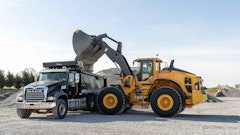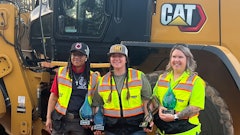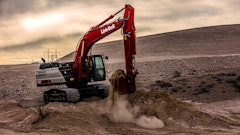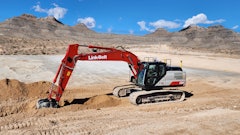
When your business hinges on a single machine, it's essential that it be configured to do just about anything its user asks of it. This is certainly true for the Case 580 Super M backhoe loader owned by Greg Dash, owner of Liberty Excavating LLC.
Although the company specializes in Class 1 and 2 septic systems, it does a variety of jobs in the communities surrounding Dash's hometown of Falling Waters, WV. "In the county in West Virginia where I live, if you look in the Yellow Pages, there are probably 185 different excavating contractors," he notes. "If you don't have a broad spectrum where you can do more than just excavating, you will starve. So we do a little bit of everything — footers, dirt work, well pumps, etc."
Dash has been in the operator's seat since he was just 8 years old, and has been actively working as an operator since he turned 19. He formed Liberty Excavating in 2008, naming it in honor of his late grandfather's former company, Liberty Backhoe Service. Since then, his son has joined him in the family business.
The rugged terrain found in West Virginia's panhandle necessitates the backhoe loader be equipped with four-wheel drive. "In March and into the end of April, it's our wet time of the year, and we plow with that machine, too," Dash says. "I wouldn't be able to work this time of year if I didn't have [four-wheel drive], not without tearing everything up. It makes that big a difference."
A heated cab is another important criterion. "Unless it's more than 10 to 15 miles, I basically drive to work," says Dash, noting the cab also has a radio/CD player. "I wish I could have gotten air conditioning, but I didn't feel like paying that much extra for something that's usually a lot more trouble because of the dust in the summer."
The extendible dipper stick on the backhoe end has proven well worth the investment. "It doubles if not triples what you can normally do," Dash asserts. "Once you have it, you won't go back to a straight stick. There's that much more you can get done with it."
The extendible dipper minimizes the time required to set up and reset the machine as you dig. "Instead of having to keep moving all the time, you [extend] the front of the stick out and you get an extra 4 1/2 to 5 ft.," says Dash. He also appreciates the added reach when clearing trees or stumps. "I can get a higher reach on it... It makes it a little bit easier. It broadens the spectrum of what I can and can't do."
Add to this the available engine and hydraulic output, and the 580 Super M has proven ideal for Dash's business. "Speed and power wise, you're going to be hard pressed to beat it," he says. "When I'm digging around sensitive areas, I can't run my machine more than mid-speed because it's so fast, you will wind up tearing stuff up, because it doesn't take much."
Dash is now considering expanding his fleet to include a compact excavator and compact track loader for Class 2 septic work, which has picked up dramatically in the area. "But I'll be honest with you, I still won't get rid of my backhoe because it has the power," he says. "There are just some jobs where you need the power, the reach and the speed."
Configured for All-around Performance
Robert Dorazio, owner of Robert Dorazio General Contractor, Avila Beach, CA, has been in construction for much of his adult life, and has owned and operated a number of different types of equipment. He's also an avid student of the industry, paying close attention to equipment trends and how they might impact his business. As such, he has a clear picture of what will and won't work for his operation.
Currently, Dorazio's earthmoving fleet includes a single backhoe loader. Its primary uses include utility installations for building construction and excavating assistance with occasional houses and commercial pads, as well as driveway access roads. "If we get concrete jobs, the backhoe digs the footings," he adds.
For the front end, Dorazio recommends a 4-in-1 bucket. "The loader should be a clam bucket or a 4-in-1, since a GP bucket cuts down on the off-the-wall jobs like grubbing or cleaning up," he explains.
For the rear, Dorazio prefers an extendible dipper stick with an outer slide design. He also likes a narrower style boom with over-center placement. "The narrow hoe boom... makes it easier to see into the ditch and also see the laborer," he says. "The over-center feature of the Case [backhoe loader] helps keep the weight on the front wheels." This helps to reduce porpoising during travel.
The auxiliary hydraulics must be able to run a breaker for tough rock conditions, concrete demolition, etc. Plus, Dorazio makes sure the backhoe is equipped with a Wain-Roy quick coupler. "That is what the rental yards around here all use," he says. "This is so we can rent different buckets."
Mechanical "wobble sticks" are still his first choice of backhoe controls. "The pilot controls are nice for making quick motions to fill in the bucket and move spoils, etc., but I would probably take the higher flow option of the basic open-center machine that is in the 'Super' package, like a [John Deere] 310SJ or a [Case] 580 Super M (now N). The wobble sticks with a standard pump are less cost to maintain."
Dorazio specs four-wheel drive largely for the added safety it can provide. "Four-wheel drive is not marketed properly," he asserts. "It is much safer for braking. Downhill braking with the load in the loader is scary once you know how much better it is with four-wheel drive." This feature also provides the ability to more effectively push into a pile, as well as helps in "getting unstuck and mucking around."
Differential locks further enhance traction by minimizing wheel spin. But models with controls mounted in the floor board have proven awkward to use. "You need one foot on the brake and one on the throttle, then how do you hold the diff lock?" Dorazio asks. "Well, you can't. So my next machine, I will add a manual override to the control to hold it so I can get out of a jam or a hole."
Dorazio makes a point to add extra lighting to his machines. "I like a lot of lights for illumination," he says. "So we have at least eight lights on the machine: two pointed low, two pointed high on the front and two pointed inward and two outward on the back."
However, cabs are avoided largely due to vandalism risk. "A cab is a liability, so we don't spec any cabs," says Dorazio. "But a clamp-on acrylic windshield comes in handy for loading dusty loads into the wind."
Smooth, Comfortable Performance Required
Klima Drainage & Land Improvements, Center Point, IA, has been installing drainage tile throughout Eastern Iowa for 30+ years. "It's long hours and hard work that we love," says Nic Klima. "We are proud to work with farmers installing drainage tile, building ponds, fixing waterways, tree removal, directional boring of pipes, etc."
The company is owned and operated by Doug Klima, who has been in the business for more than 40 years. He started out as an operator for his father, Mike, before going on to become co-owner and eventually sole owner of the business. His sons have since joined him in the operation.
"I've grown up operating backhoes. It's in my blood," says Klima, who recently competed in the finals for the Case Triple Threat Rodeo at World of Concrete in Las Vegas. "My older brother, Michael, and I both attended Northwest Community College (NWCC) for Heavy Equipment. We are both operators in the business and we have six other employees."
In addition to two tiling machines, a couple Link-Belt excavators and horizontal directional drills, the company owns five Caterpillar 420E backhoe loaders. "They're mainly used for digging connections for the tiling machine," Klima says. However, they are also used to remove trees and rocks and look for existing tiles in fields, dig septic systems, even tear down small sheds. "A little bit of everything really."
Features essential to Klima Drainage's applications include operating weight, smooth operation, a smooth ride and dealer reliability to keep equipment working. A powerful hydraulic system is also important to ensure the backhoe loaders are "reliable, smooth but fast, and powerful." This is one reason the company turns to the Cat machines. "They're smoother, more powerful and they just seem to last a little longer, as well," says Klima.
The desire for smoother control makes pilot-operated joysticks for the backhoe appealing. "They seem a lot more up to date," Klima says. "The old ones are wobble sticks up in front of you. [With the joysticks], you get more room for your feet and beside you. It's just more comfortable to run them." And contrary to some operators' opinions, he argues there is no sacrifice in "feel" when digging. "You eventually get used to it."
Because of the extensive amount of time spent in the machines, operator comfort is a top priority. Klima Drainage looks for a comfortable, roomy cab, air conditioning, heat and a good radio.
A ride control system is also a necessity. "It's just a lot more comfortable for the operator," says Klima. "The front bucket will float up and down while you're driving. If you drive across the field and you hit a bump, it will absorb a lot of shock. Or if you're driving down the road, it will absorb a lot of that shock, as well."
Heavy-duty Machines for Tough Applications
Attila Varga and his wife Christina started Varko Excavating Inc. in 1997 with the purchase of a new John Deere 410E backhoe. Now serving the entire Calgary, Alberta, metropolitan area, the company began operation as an owner/operator doing small jobs primarily for a concrete curb and gutter contractor.
"We were contracted on an hourly basis to break out and remove concrete sidewalk, curb and gutter which needed to be replaced," says Attila Varga. "Fast forward 15 years, and Varko Excavating is still working with that same concrete contractor supplying two removal crews, each consisting of a wheeled excavator, backhoe loader and gravel trucks."
The company has expanded the scope of its services substantially. Its primary focus is now complete earthwork for new commercial, institutional and residential buildings, including site grading, site services and foundation excavation/backfill. Its fleet includes in excess of 20 pieces of heavy equipment, including excavators, dozers, loaders, compact track loaders, ride-on compactors, gravel trucks and, of course, backhoe loaders.
"We currently own four backhoe loaders and at one point we had as many as six in our fleet," says Varga. "All of our backhoes have been John Deere 410 models in three different series (E, G and J)."
When shopping for a backhoe loader, there are several factors Varga takes into account. "I've always elected to go with the 410-sized machines for their extra weight and power advantages over their smaller counterparts," he says. "The extra weight and breakout force is desirable for the conditions in our area. We have a wide variety of soil conditions ranging from dry sand to granite, and hard clay to cobble. In the winter months, the ground freezes to average depths of around 4 ft. and can occasionally reach down to 7 ft. or more. Digging through this frost requires a strong and heavy machine."
Varga's operators appreciate the creature comforts available on the machines. "Our operators like the John Deere backhoes for the large comfortable cab. We always buy them with all the deluxe comfort features available, such as heater/air conditioning, stereo, pilot control," says Varga.
Other "must haves" include four-wheel drive and an extendible dipper. "I only buy backhoes that are four-wheel drive (front-wheel assist) and have extendible dipper sticks with auxiliary hydraulics," he states. "The extendible dipper must be an outer box extension, most common in John Deere, Case and the new Cat machines."
The backhoe loader must be able to accommodate multiple attachments, including 12-, 18-, 24- and 36-in. backhoe buckets, a hydraulic breaker, hydraulic vibrating plate tamper, ripper for frost and/or rock and front forks.
"We consider our backhoes to be the Swiss army knife of equipment," says Varga. "Typically, our backhoes are only used for digging or trenching around 25% of the time. They are more commonly used for breaking concrete and/or rock and most commonly for backfilling and compaction along foundation walls and utility trenches."
All of the backhoe loaders are also set up to tow a pickup truck behind them. "This allows our operators to be fully self-contained," says Varga. "They can hook up to their company pickup truck with a tow bar and get around the city from job to job and always have their truck equipped with fuel, tools and such on site."
Although Varko Excavating has expanded into larger earthmoving projects, Varga continues to see backhoe loaders as a mainstay in the fleet. "Their mobility is especially useful," he points out. "We can easily dispatch a machine to a jobsite, whether it be for a quick 20-minute job to lift or clean up something at one site, or to do a more involved job like excavate a broken sewer line and then backfill and compact it once the repair is made.
"I don't ever envision a time where we will phase out backhoe loaders," he states.
Longevity and Durability Are Essential
Laclede Gas Company is the largest natural gas distribution company in Missouri, serving approximately 631,000 residential, commercial and industrial customers in the City of St. Louis and 10 other counties in eastern Missouri. Mike Menendez, assistant superintendent of transportation, handles the specifications for the company's extensive equipment fleet, including its roughly 75 backhoe loaders.
"We do several different things with backhoes," he says. "We have some full-size backhoes, like John Deere 410s and 310s. Most of those are used on what we consider a main crew. In other words, they're putting brand new gas mains in the ground." These can range anywhere from 6- to 24-in. lines.
"We also use [backhoes] in our service department," he continues. "They're used to install services from the mains to the homes or to a business, and everything in between. They're also used for doing maintenance on underground utility lines... If we have a leak, they may be used to dig up that leaking area and service that main."
Most of the backhoe loaders used for service and maintenance work are JCB 1CX and 2CX models. "One of the reasons we get the JCBs is that they are four-wheel drive," Menendez notes. However, a rugged design is perhaps the most critical factor. "It's a smaller backhoe, but it's heavy duty."
Because most employees are not full-time operators, and multiple employees with varying experience levels may use it over the course of a day, the machine's ability to withstand potential abuse is paramount. "One of the things we look at when we're buying backhoes is longevity — that it has the durability. It has to have a heavy-duty loader. It has to have a heavy-duty backhoe," says Menendez. "We're rough on stuff. Durability is a big factor."
Attachment capability is another big factor in backhoe loader selection. "We use hydraulic breakers... We also use tampers," says Menendez. "Once we are done with a job, we'll use that tamper to tamp down the line." Consequently, he specifies high-flow hydraulics whenever possible. "If there is an option between a standard machine and a high flow, I'll get the high-flow hydraulics."
Extendible dippers are specified on full-size models to provide as much reach and digging depth as possible. This allows for any possible contingency once crews are in the field. "It may say in our prints that [a line] is 5 ft. deep," says Menendez. "It could be 20 ft. deep because road construction and what not has changed our elevation over the years," Menendez points out.
The John Deere models are also spec'd with "wobble sticks" for the backhoe. "Our [operators] are a little bit older, and they have better feel with those," says Menendez. "When you get into something, you can kind of feel it better on the hydraulics than you can on the electronic pilot controls."
All models (excluding the 1CX) are outfitted with cabs. A clear view to the work area is a high priority. This "The glass needs to be in such a fashion that you don't have blind spots where you're digging," says Menendez. "We're digging around gas lines. There is no room for error there. Visibility is a big thing."





























